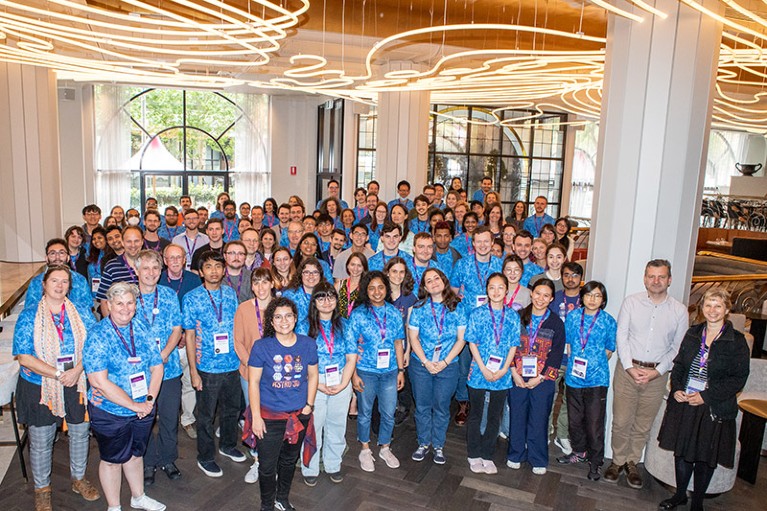
The Australian Research Council Centre of Excellence for All Sky Astrophysics in 3 Dimensions (ASTRO 3D) has reached 50% female personnel in five years.Credit: Cristy Roberts, ASTRO 3D
An Australian astronomy research centre has achieved gender parity across all its personnel with a five-year programme of education and affirmative action. Leaders say their approach could be applied to other organizations.
The Australian Research Council Centre of Excellence for All Sky Astrophysics in 3 Dimensions (ASTRO 3D) is a government-funded project involving nine Australian universities that focuses on understanding the evolution of the Universe. In early 2018, 38% of the centre’s roughly 150 personnel were women. But by 2023, half of its more than 300 personnel were women, according to a report published last week in Nature Astronomy1. Some people were non-binary or did not wish to self-identify.
“This is a great achievement, and encouraging to those of us who have been pushing for some time for better gender representation in the scientific workplace,” says Jocelyn Bell Burnell, an astrophysicist at the University of Oxford, UK.
Retention boost
Over the past three decades, less than one-quarter of senior positions in astronomy in several countries have been held by women, even though women complete up to 40% of PhDs in the field worldwide. At the current rate of growth, it would take more than 60 years for astronomy to reach gender parity, says study co-author Lisa Kewley, an astronomer and founding director of ASTRO 3D, which is based at the Australian National University in Canberra.
To speed things up, Kewley and her team designed a programme to make ASTRO 3D’s hiring process, staff retention, leadership and workplace culture more equitable for women. ASTRO 3D required all hiring committees and shortlists of candidates for postdoctoral roles across its nine universities to be 50% people who identify as women. The centre also required all its members, including those who were selecting job candidates, to attend a two-day workshop on implicit bias and stereotypes.
The team’s efforts paid off: among the 48 postdoctoral researchers who landed a post at ASTRO 3D through job advertisements over the five-year period, just over half were women. Furthermore, the number of female PhD students jumped from 33% in 2018 to 53% at the start of 2023. Kewley says a tipping point was reached when the centre’s staff grew to 40% women in 2021, with the number of PhD students accelerating since this time, particularly among teams led by women. “It was really amazing to see the numbers going up over time,” says Kewley. She adds that recruiting more women didn’t come at the expense of men: the number of male PhD students and postdoctoral researchers also grew between 2018 and 2023.
In Australia, nearly two-thirds of women in junior postdoctoral roles in astronomy leave the field before they advance to senior postdoctoral roles. Kewley and her colleagues aimed to counter this statistic by increasing the number of women in leadership roles and providing anonymous or external channels for reporting behaviours that breach the centre’s code of conduct, such as microaggression and sexism. The team also implemented family-friendly policies, such as holding meetings only between 10 a.m. and 2 p.m., and providing financial support for caregivers and people experiencing hardship.
Almost 60% of female PhD students who had been at ASTRO 3D in 2017 or 2018 were still there after five years, with many snapping up postdoctoral roles at the centre’s affiliated universities. More than two-thirds of female postdoctoral researchers were also still working at the centre in June 2022, which Kewley says indicates that the team’s retention strategies were effective.
Sharing the benefits
The initiative offers a road map for improving gender equity at other research organizations, says Kewley. “We really hope other institutions can apply the same methods and have success with them as well.”
Nalini Joshi, a mathematician at the University of Sydney in Australia and founding co-chair of the national programme Science in Australia Gender Equity, says the results offer a “clear illustration of how dedicated and informed leadership can drive equity”. But she adds that broader and longer studies are needed to determine whether ASTRO 3D’s initiatives lead to lasting results, and whether they can be applied to other universities and large organizations, particularly among researchers at later career stages.
Kewley and her team are currently implementing strategies to recruit and retain researchers from other under-represented groups, including the Indigenous and LGBT+ communities, and people with disabilities. “True diversity is not just about binary gender,” she says. “We shouldn’t just stop here.”

